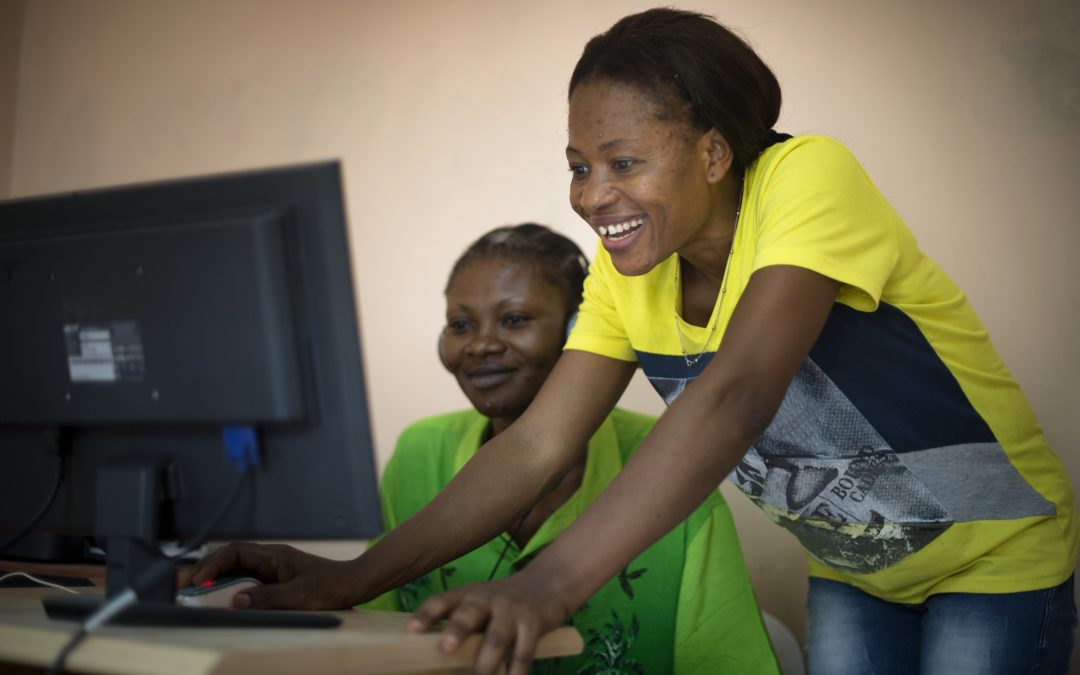Budiaki helps her student to connect to online social media during basic computer skills training session in the Information technology classroom of the Women’s Centre for urban refugees in Nouakchott, Mauritania. Photo credit: © UNHCR/Agron Dragaj
Two years since the inception of the Connectivity for Refugees initiative, UNHCR’s Innovation Service is taking a moment to reflect on how things have progressed. Through a series of short blog posts we’ll unpack the lessons learnt from pilots that have been undertaken across a number of countries, to work out what is having the most impact, and identify obstacles and challenges that have hampered progress. Over time, we’ll also be using this blog to highlight case studies of the different pilots that are taking place.
Connectivity for Refugees formally started as an initiative in November 2016 with the launch of research conducted by Accenture Development Partnerships, and an associated Connectivity for Refugees report. This research was commissioned by UNHCR’s ICT division which has traditionally supported connecting humanitarian responders. Due to technological advancements, and other counterparts in the humanitarian sector expanding the scope of their ICT solutions to cover affected populations, UNHCR’s ICT division aimed to expand UNHCR’s remit to include refugees access to the internet. The research aimed to determine what impact could be made on the lives of refugees through internet connectivity, and to develop a practical route towards connecting those who are currently not connected – bridging the digital divide. Given UNHCR Innovation Service’s experience in piloting and developing new initiatives, Connectivity for Refugees was internally handed over to the Innovation Service for this incubation period.
The initial strategy was broken into three core pillars of connectivity, each with a subset of more practical approaches that would be applied. Combined with the strategy, a fundraising roadmap was laid out to support both global and field level interventions. A specific focus was given to partnerships, with a large portion of the strategy being driven through either advocacy towards or collaboration with governments, private sectors partners, NGOs or donors to deliver connectivity for refugees. The strategy pillars were:
Accessibility
- Advocate for mobile network operator infrastructure
- Advocate to governments for infrastructure and access
- Advocate to internet service providers and alternative technology companies for infrastructure
- Make targeted investments in infrastructure
Affordability
- Negotiate refugee-specific plans and discounts
- Subsidize devices and mobile/internet plans
- Deploy and expand community internet access centres
Usability
- Develop and implement training programmes
- Enable an ecosystem for digital service delivery
- Facilitate development of refugee relevant content
Over the first two years, a core team was established at headquarters to implement the strategy. An approach was taken to bring country-level coordinators on board to drive forward pilots in select countries: Jordan, Greece, Chad, Malawi, Tanzania, and Uganda have all had staff with dedicated focus on Connectivity for Refugees as part of their terms of reference. The criteria for selection of these countries was opportunistic, capitalising where there were existing activities from either UNHCR or its partners, or where specific interest was demonstrated by the operation to move forward with Connectivity for Refugees pilot activities. Pilots focussed on working in partnership with different actors to provide connectivity services, both at an individual level by advocating to network operators to extend infrastructure to refugee hosting areas, to working with large technology companies to boost community access through Wireless LAN at connected centres, with NGO Partners in emergency situations, and other interventions from providing devices to specific groups to mobile charging stations.
To note: UNHCR is tackling the initiative of Connectivity for Refugees across all regions. The above selection was simply those operations supported in some way by the global level Connectivity for Refugees team. For instance in Ghana, UNHCR is successfully working with Intelsat and Comsys Ghana to provide connectivity through community ICT labs which wasn’t part of the HQ-driven pilot process.
Within the pilot countries, efforts have spanned from working closely with Mobile Network operators and third parties like the GSMA to support infrastructure rollout to new influxes of refugees, to satellite connectivity in rural areas using innovative business models to enhance sustainability, as well as connected community centres and solar charging stations. More substantive documentation around these pilots is being developed and will be posted through this site in due course.
Making Progress – Where are we today?
While the pilot interventions are numerous, and across a diverse range of contexts, UNHCR is still in the process of understanding the effectiveness of each of the initiatives. At the beginning of 2018, an interim internal assessment was undertaken. This looked at what is working, where there are challenges and then an assessment along the following criteria: effectiveness, efficiency, relevance, sustainability, and innovation. Emphasis is now being placed on evidence, data and documentation for the initiative, to enhance scalability of good practices and facilitate transfers between operations.
The overarching takeaway from this evaluation was that the project is well-positioned to move on from its ‘pilot’ / ‘proof of concept’ stage with a number of initiatives commencing for the first time towards a focus on scale, extended buy-in and systematic change. There have been numerous forays into different types of interventions across all strategy pillars that has had a positive impact on the communities being served by them, for instance positive feedback from App Factory students in Malawi, connecting community centres in Jordan, or extending cellular coverage through a partnership with Vodacom in Tanzania.
While there are have been successes, there are also a number of activities that have not been fully capitalised on, and – as is important when piloting new initiatives – a fair number of lessons that we’ve had to learn about how we can best achieve the goals we’d laid down at the outset.
Stay tuned for our next post next that will unpack lessons learned on the initiative to date in detail.

